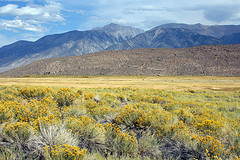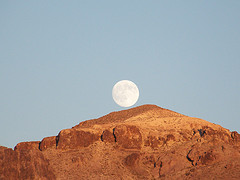Private Lands in the #11 State for Biodiversity and Extinctions
By: Amos S. Eno
Posted on:08/26/2010 Updated:01/04/2016The state that spawned the Sagebrush Rebellion is quietly fomenting a new revolution: collaboration in the name of conserving wildlife and water.
“I’m such a fan of this PLN, by the way,” says Connie Lee, Private Landowner Incentives Coordinator for the Nevada Department of Wildlife, or NDOW. Music to my ears. Connie first got in touch with us because she wanted to request that we feature her Private Landowner Program on the PLN website, and of course we were happy to oblige.
Even faithful users of our websites are often unaware that they can simply click on the "add me to PLN” button and submit their listing information directly to us. In addition, experts who wish to share information or expertise may also for publication.
Connie has been coordinating Nevada’s private lands program since 2005, when the federal Landowner Incentive Program was begun based on the successful Texas private lands program. However, after three to four years, LIP funding was yanked, which made the private lands program lose a lot of credibility with private landowners across the country.
Connie is still working to award funds allocated in 2007, not surprising considering the new ground she’s breaking in a state where distrust of the government is huge. She is especially excited about the work of some ranchers in northeastern Nevada, the Shoesole Management Team. Agee and Vicki Smith of the Cottonwood Ranch are seeking to implement holistic range management. They meet twice a year with the BLM, Forest Service and NDOW. They recently added fish passage and riparian fencing to their land. “They are awesome,” says Connie.
This region, which actu ally spawned the Sagebrush Rebellion, is also the region that spawned the National Fish and Wildlife Foundation’s Bring Back the Natives Program in 1991, my second year as Executive Director there.
ally spawned the Sagebrush Rebellion, is also the region that spawned the National Fish and Wildlife Foundation’s Bring Back the Natives Program in 1991, my second year as Executive Director there.
My conversation with Connie helped me recall how extraordinary our seventh largest state really is. The following statistics come straight out of the Nevada Wildlife Action Plan. Nevada is:
- 11th among the states in number of species extinctions
- 11th in overall biological diversity
- 5th in number of endemic species
- Nevada has the fourth greatest percentage of fishes at risk
- Nevada is third in the nation measured by greatest percentage of amphibians at risk
- Nevada has the third highest percentage of species at risk (after Hawaii and California) with 263 species of conservation priority
- Of the state’s 71 million acres, about 61 million are managed by the federal government.
Many visitors race through at 70 or 80 mph and have no clue what they are passing. Nevada is the most mountainous state in the Union, with each small range isolated from the next by the Nevada desert. As Connie says, “you could go down any one of these valleys and be amazed.”
Will Molini, former director of NDOW and one of the first members of the NFWF Board of Directors, expands on this topic by noting, “In Nevada where 87% of land is in public ownership, the private lands are some of the really key areas with water resources and water availability. Sometimes the checkerboard railroad land patterns, where private lands are interspersed with public, make them even more important to wildlife.”
Connie explains that “Nevada has a lot of endemic species that rely on riparian areas,” so private lands and waters are key to biodiversity. “A lot of landowners have done great things with their land, but we have an aging ranching population that faces estate taxes and development threats. In particular,” she continues, “they face heavy pressure to sell their water rights to the southern Nevada water authority,” aka Las Vegas.
In such a regulatory and financial environment, how can a rancher not sell out? Connie’s programs seek to put ranchers together with information and funding resources to help them hang on to their property in whatever way will work. In particular, Connie is interested in reaching out to private hunting reserves, LLCs that focus on the many species of big game Nevada has to offer: elk, bighorn sheep, antelope, and mountain goats.
Agricultural easements can also be a great help to ranchers who are strapped for income. “Typically there have been very few private conservation easements in Nevada, but we’re starting to see a big interest.” Connie is hopeful that the energetic NRCS State Conservationist, Bruce Peterson, will also be able to make a difference for private landowners. With new NRCS staff dedicated to farm bill funding, she hopes to see an exponential increase in the expenditure of dollars in support of private land conservation.

Connie’s latest endeavor is a pilot voluntary public access program, using FSA dollars to provide support to landowners willing to provide access across or through their lands to public land inholdings. Potential cooperative actions with landowners include signage, gate or road repair or the installation of cattle guards.
As our conversation ends, Connie repeats, “PLN, what a great clearinghouse and opportunity to bring focus to private lands. I get the updates and enjoy reading them. If you could just consider adding a few more resources I know of . . .”
Music to my ears.
 Sign In
Sign In
 Sign In
Sign In
